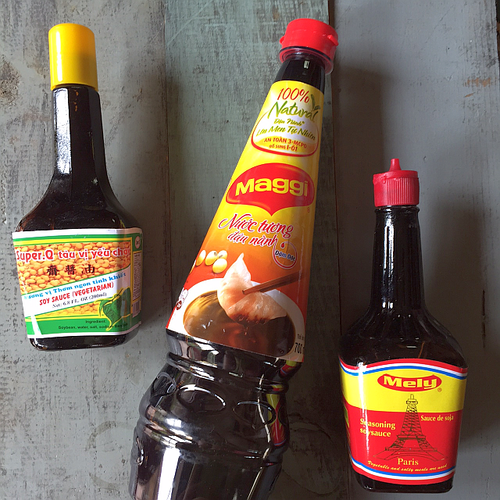
I am guilty of spending too much time in the condiment aisle at Asian markets. In fact, my husband told me he was going to Target while I perused Shun Fat (Thuan Phat) market in Garden Grove’s Little Saigon. It’s part of a chain of mega Vietnamese-Chinese markets in California, Nevada and Texas.
The condiment aisle is long and filled with a vast array of Vietnamese, Thai, Chinese, and a few Japanese ingredients. I’ve been to this market many times and always look at the fish sauce first. On this trip, I bought a new brand I’d never seen before from Vietnam. The surprises had to do with Maggi Seasoning sauce, a popular cult condiment. What I found were a Nestle version produced in Vietnam(!) and a Vietnamese-French knockoff. I also bought a “vegetarian” version from Vietnam. “I see what we’ll be tasting when we get home,” Rory said when we looked into my shopping cart.
When we returned home, I opened up the Vietnamese Maggi to serve with dinner. Nestle makes Maggi seasoning sauce for specific audiences and each one is a little different. What would the one for Vietnam taste like?
I knew that this bottle was truly from Vietnam because the label was mostly in Vietnamese and the bottle itself was flimsy, a bit squishy, made from thin plastic like you’d find in Vietnam. But Nestle, which owns Maggi, made the product. I was gleeful.
The taste wasn’t as salty as the Chinese, French, German or Mexican ones I’d tried. It’s on the sweet side and a touch lighter than what I’ve eaten in the past. The Vietnam-version reminded me of mixing Bragg’s liquid aminos with sugar. However, there’s wheat in the Vietnamese Maggi so it’s not a gluten-free product, if that matters to you. It was pleasant and reinforced the delicate, slightly sweet flavors of food in Vietnam. Note that the label features a dumpling being dipped into the sauce. In Vietnamese, this bottle of Maggi is marketed as nuoc tuong dau nanh, soy sauce made from soybeans, not as Maggi. It’s len men tu nhien (naturally fermented) to underscore the 100 percent naturalness.
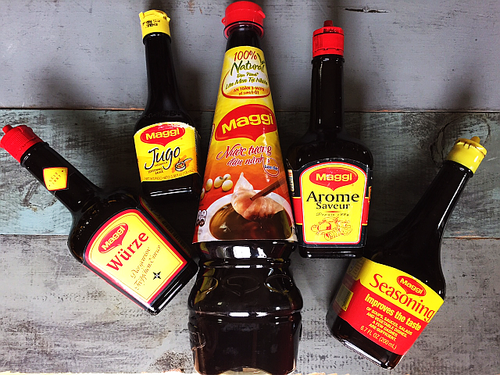
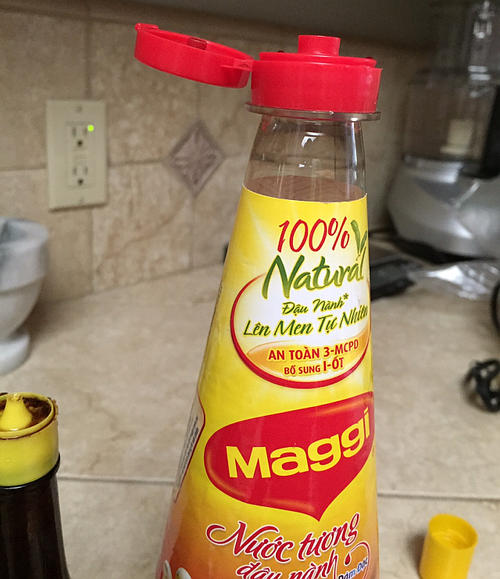
When I’ve been to Vietnam and tasted certain soy sauces, they tasted like Maggi to me (scroll down to the bottom here to see a Vietnam-made Cholimex bottle). When I mentioned it to locals, I often got blank stares. Perhaps given the 40+ years since the Fall of Saigon and the fact that most people in Vietnam were born after 1975, Maggi isn’t really a big deal in the country but rather, it’s become a popular form of soy sauce. Or, perhaps Nestle has positioned Maggi to become the go-to soy sauce in Vietnam. If that’s the case, it has big implications because in general, soy sauce offers a different set and range of flavors. Maggi is unique (or so I thought).
For Vietnamese expatriates, Maggi is something special, not a generic soy sauce. The bottle of Mely from France was a total knockoff of the prized French version of Maggi. The Eiffel Tower tipped it off. On first taste, it was very assertive – salty and lacking finesse like the French Maggi, which contains a touch of MSG to round things out. Mely was alright and at $3.59, wasn’t exactly a steal. The small French Maggi runs about a dollar more at Shun Fat, which has fair prices because it sells volume.
The vegetarian mock Maggi was just bleh. When soy sauce is labeled vegetarian, it’s practically like saying water is gluten-free. It’s ludicrous labeling but I was willing to give the product from Vietnam the benefit of the doubt. It cost $1.59 and unfortunately tasted like it did. The shape of the bottle evoked the Chinese Maggi bottle but the color and overall flavor was thin. Very sad. This brand has been around for years but I didn’t get around to tasting it until now. I don’t recommend it.
I returned to tasting Mely and you know what – on a second tasting, it was alright. A close runner up to the actual French Maggi.
Sometimes knockoffs are okay, and sometimes totally off the mark. Another thing I noticed this time around was the nipple-shape pouring spout. Real Maggi has a distinctively curved spout that makes dispensing easy. You can control the amount that flows from the bottle. The knockoffs likely don’t have the same kind of manufacturing process to replicate that; the technology and/or style may be proprietary to Nestle. What none of these have yet to get right is a hinge that doesn’t threaten to break. I use my bottles often, opening them harshly to sprinkle onto banh mi. Maybe I’m impatient but eventually, the top breaks off.
If you see the Maggi Seasoning from Vietnam, try it for roughly $2.59 a bottle. You may need to use a little more than usual because it’s not as salty as other versions of Maggi. On the other hand, it may remind you of food enjoyed Vietnam, which tends to have a lighter flavor than Vietnamese food made elsewhere. As for me, I’ve added to my Maggi collection.
If you’re not familiar with Maggi Seasoning sauce, here’s a primer on it (it’s a cult condiment of Vietnam). If you are a Maggi fan, which version is in your pantry? How do you like to use it?
Related posts and recipe
- Chanterelle and Garlic Butter Noodles
- Maggi Seasoning Sauce substitutes that are gluten-free MSG-less
- Wheat Berries with Tofu and Kimchi
- Many Viet sandwiches (click here for banh mi recipes on VWK)













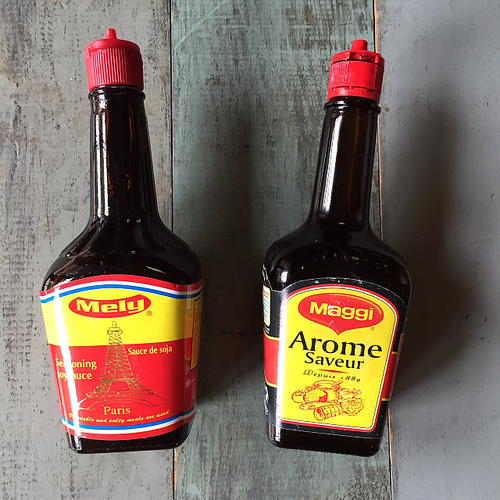
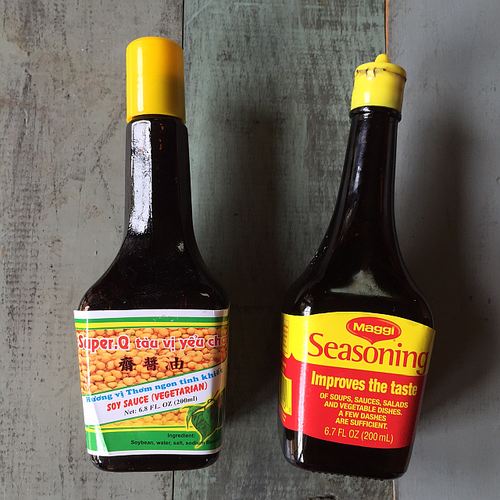
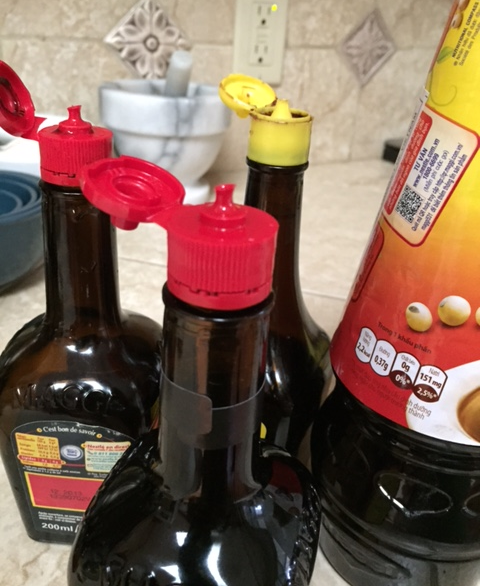




Deb says
Big Maggi fan, but in the last couple of years developed a complete intolerance to wheat. So hunting for gluten free and the primary ingredient is wheat! Do you have suggestions?
Andrea Nguyen says
Bragg's Liquid Aminos -- they upped the sodium and it now tastes a lot like Maggi. https://bragg.com/products/bragg-liquid-aminos-soy-alternative.html
Kreation says
Yes, I have tried that Maggi imported from Vietnam under Nestle before I found your article. It tastes very good.
Wayne says
Wife just bought one from Lam Seafood and the bottle did not say where it is made. This is really frustrating since I won't buy anything made in China or Viet Nam. Can never trust these communists. I wonder where is the FDA on letting people selling thing without approval.
Andrea Nguyen says
Well, I've not had too many problems with products made in China or Vietnam. Nestle owns Maggi. You do want to read the fine print -- which seems to get smaller all the time!